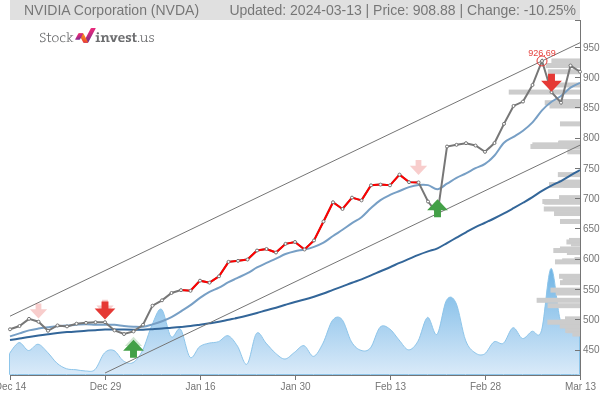Technical Analysis
NVIDIA Corporation (NVDA) experienced a slight dip in its stock price, closing at $908.88 on March 13, 2024, which marks a decrease of $10.25 or 1.12% from the previous close. Despite this decline, the stock has shown significant strength over the past year, with a year low of $233.60 and a high of $974.00, indicating considerable volatility and growth potential.
The technical indicators provide mixed signals. The Relative Strength Index (RSI) stands at 70, teetering on the edge of being considered overbought, which suggests that the stock might face a short-term pullback. However, the strong upward trend is supported by the stock’s performance relative to its moving averages – it's significantly above both the 50-day moving average ($676.41) and the 200-day moving average ($504.44). The MACD (Moving Average Convergence Divergence) of 60.38 further corroborates the bullish trend over the past three months.
With an Average True Range (ATR) of 4.33, NVDA is showcasing relatively moderate volatility, which is considerable given its price range. The stock has defined support at $875.28 and resistance at $919.13, indicating potential for movement within this range in the short term.

Fundamental Analysis
NVIDIA’s market capitalization stands impressive at approximately $2.27 trillion, reflecting the company’s dominant position in the semiconductor industry, particularly in segments like gaming, data centers, and, more recently, AI technology. The Price-Earnings (PE) ratio is quite high at 76.06, suggesting that investors are expecting high growth rates in the future.
The company has not declared any dividend, focusing instead on growth – a strategy that might appeal to certain investors. With an earnings per share (EPS) of 11.95 and significant analyst optimism (35 buys, 3 holds, and 1 sell), the fundamental outlook for NVDA appears strong. This optimism is further buoyed by NVDA's leadership in the AI space, as highlighted by recent news emphasizing the company’s impact on generative AI startups and its volatile yet robust, stock performance.
Despite a discounted cash flow (DCF) valuation significantly lower than the current trading price, suggesting potential overvaluation, NVIDIA's strategic positioning in growth sectors such as artificial intelligence (AI) might justify the premium.
Intrinsic Value and Long-Term Investment Potential
Calculating the intrinsic value using a DCF model yields a figure far below the current market price, indicating that the stock might be overvalued from a traditional valuation standpoint. However, NVIDIA's pioneering role in AI and its strong fundamentals could provide significant upside in the long term, offsetting concerns of overvaluation for growth-focused investors.
The consensus target and the high level of optimism among analysts suggest strong belief in NVIDIA's long-term growth trajectory, driven largely by ongoing innovations and its expanding footprint in the AI segment.
Overall Evaluation
Given NVIDIA’s technical position, strong fundamentals, and the growing importance of its core markets, the stock is categorized as a Buy. Short-term traders might exercise caution due to the stock's high RSI and the potential for volatility, as indicated by the recent analysis comparing its fluctuation to bitcoin. However, for long-term investors, NVIDIA presents a compelling growth story, particularly for those keen on exposure to AI and high-performance computing sectors.
The recommendation to buy is based on NVIDIA's dominant market position, robust financial health, significant growth potential in AI, and the bullish sentiment among analysts. Investors are advised to be mindful of the high valuation and to consider NVIDIA as part of a diversified investment strategy focused on growth.


 NVDA
NVDA



